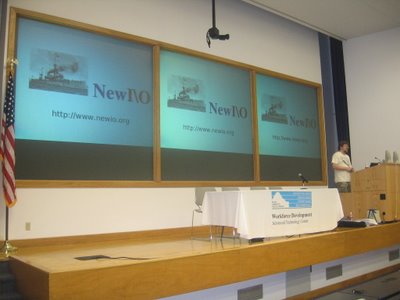The
October CACTUS Newsletter has a review of my September presentation. It is real nice to see NewI\O described in someone else's words. Here is the relavent section:
September Meeting Reportby Lindsay Haisley
Our presentor and guest this evening was Chris Nystrom, a system administrator for Oracle. After a few asides about how Oracle is undertaking a "huge Linux migration", he got down to a discussion of his own project, NewI\O.
Chris has tackled the problem of Rich Internet Applications head-on. While many people are still working with and trying to perfect web-based application frameworks, he's basically tackling the problem with a new TCP/IP technology altogether. As Chris says on his
NewI\O website, "NewI\O has nothing to do with the World Wide Web".
Think of accessing a server shell with telnet, or a dumb terminal, and then educate the client/server pair to the 21st century to understand the event-driven programming model over the Internet, and you have a very rough approximation of NewI\O. Applications run on a server which users access with a special client, similar to a
browser. The NewI\O client processes not just text input, but mouse events, screen resizes, key presses, etc. and generates event messages which it sends to the server application, which processes client events and sends its responses back to the client for display. Audio I/O, control of peripherals, etc. is handled on the client side to address latency issues. The division of labor between the client and server is still an issue under development. Event driven programming can be quite complex, with multiple event queues, downloadable resources and the like.
The API will be simple, with a library (written in C) which can easily be wrapped for use by other languages, and conversion of existing applications written in C will be easy by design.
Will NewI\O be an expensive, proprietary system? No! It's Open Source, and will remain so. Chris made some effort to get Oracle to back the project and sent a white paper on it to a number of management types at Oracle, including The Oracle Himself, Larry Ellison. All he got for his troubles was a reprimand for jumping the chain of command and it became obvious that Oracle wasn't interested. Pity! IBM has gotten solidly behind the Open Source concept and a number of FOSS projects such as EVMS, to which they've contributed greatly. Some companies just don't get it yet.
Chris ended his presentation with a live demo. While the apps he demonstrated were quite simple in themselves, they served as an exciting proof of concept for NewI\O. This one looks to me like an Idea Who's Time Has Come!










